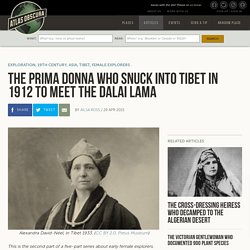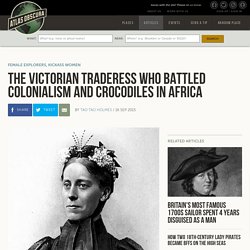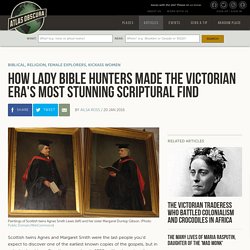

In pictures: 10 trailblazing British women in science and maths. The Prima Donna Who Snuck into Tibet in 1912 to Meet the Dalai Lama. Alexandra David-Néel, in Tibet 1933.

(CC BY 2.0, Preus Museum) This is the second part of a five-part series about early female explorers. The first part can be found here. The first western woman to gain an audience with the Dalai Lama, the Belgian-French Buddhist scholar Alexandra David-Néel is best known for her forbidden journey to Lhasa, when, aged 55, she ascended the Tibetan steppes on a trek that saw her so malnourished she had to eat the leather from her boots to stay alive. From the age of two, David-Néel was wandering away from her parents in the streets of Paris, where she was born in 1868. The Cross-Dressing Heiress Who Decamped to the Algerian Desert. Isabelle Eberhardt in the Sahel desert, circa 1900.

(Photo: Wikipedia Commons) This is the third part of a five-part series about early female explorers. The first and second parts are here. Just as the 19th century was drawing to a close, a penniless 22-year-old explorer and author named Isabelle Eberhardt left an unhappy life in Switzerland to roam Algeria, join a mystical Sufi Muslim sect, and dress as the male Arab she saw herself as. Following an assassination attempt against her, the woman sometimes referred to as "the first hippie" died in a flash flood in the Sahara at the age of 27. “I will never be content with a sedentary life; I will always be haunted by thoughts of a sun-drenched elsewhere,” wrote Eberhardt in The Nomad: The Diaries of Isabelle Eberhardt.
Born in Geneva to an aristocratic mother and the family tutor—an ex-priest turned anarchist named Alexandre Trofimovsky—Isabelle Eberhardt was fluent in six languages, including Arabic, as a 16-year old. Algeria was calling. The Victorian Gentlewoman Who Documented 900 Plant Species. Marianne North painting a Tamil boy in Ceylon, 1877.

(Photograph by Julia Margaret Cameron) This is the first part of a five-part series about early female explorers. Born into wealth in 1830 as the eldest daughter of an English member of parliament, like many upper class women of the time, Marianne North devoted herself to painting flowers. Unlike other Victorian women, though, North could not be satiated by roses. At age 40, she set off alone to travel the world, braving rough ship and living conditions to document over 900 plant species in just 14 years. Honeyflowers and Honeysuckers, South Africa - Marianne North. The Victorian Gentlewoman Who Documented 900 Plant Species. The Victorian Traderess Who Battled Colonialism and Crocodiles in Africa. Mary Kingsley, perhaps the most fashion forward early explorer.

(Photo: Courtesy of The Victorian Web) Explorer, trader, and anthropologist Mary Henrietta Kingsley was once saved from a grisly death by her proper and sturdy Victorian skirt. Kingsley, then 31, had been attempting a shortcut through the forest near the West African village of Efoua, when she suddenly found herself at the bottom of a game pit lined with spikes. “It is at these times you realize the blessing of a good thick skirt,” Kingsley states in Travels in West Africa (1897).
“Had I paid heed to the advice of many people in England... and adopted masculine garments, I should have been spiked to the bone and done for. Mary Kingsley treated such travel mishaps with self-deprecation and nonchalance, whether she had fallen into a spiked pit or through a villager's roof. Mary Kingsley grew up in Highgate, England, an armchair explorer in her father’s library of science and travel literature.
The Scrappy Female Paleontologist Whose Life Inspired a Tongue Twister. Mary Anning, pictured pointing at a fossil on the ground next to her dog, Tray.

(Image: Public Domain/Wikimedia Commons) Say "she sells seashells by the seashore" quickly, three times in a row. Now, try the more historically accurate version: Mary Anning peddles dinosaur parts on the Jurassic Coast as one of the world's first, unheralded fossil hunters. Born in 1799, Anning ran a fossil stand on England’s Dorset Beach, also known as Jurassic Coast, and it's often said that she was the real-life inspiration behind the famous tongue twister. At age 12, she dug up a 200 million year-old marine reptile—the first complete ichthyosaurus skeleton to be acknowledged by the Geological Society in London. How Lady Bible Hunters Made the Victorian Era's Most Stunning Scriptural Find. Paintings of Scottish twins Agnes Smith Lewis (left) and her sister Margaret Dunlop Gibson.

(Photo: Public Domain/WikiCommons) Scottish twins Agnes and Margaret Smith were the last people you’d expect to discover one of the earliest known copies of the gospels, but in a dusty closet in an Egyptian monastery in 1892–without a university education or formal language training between them–the God-fearing twins uncovered the Syriac Sinaiticus.